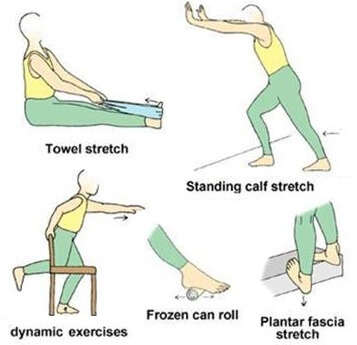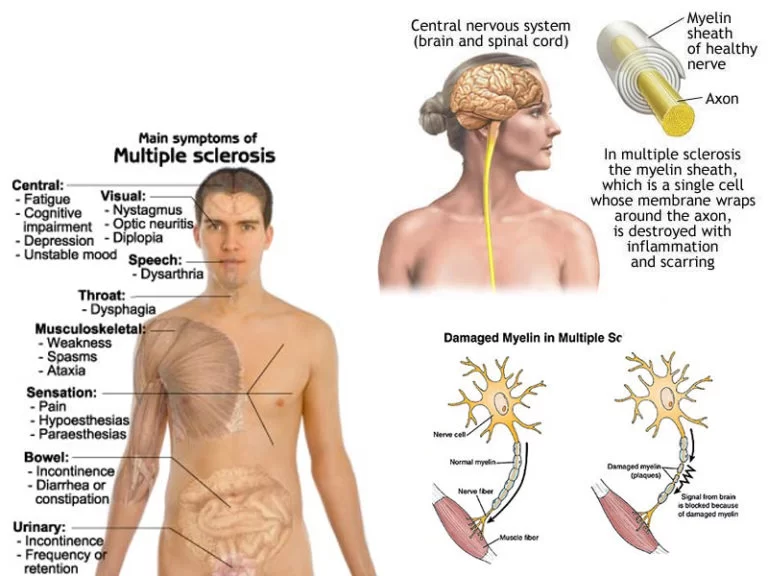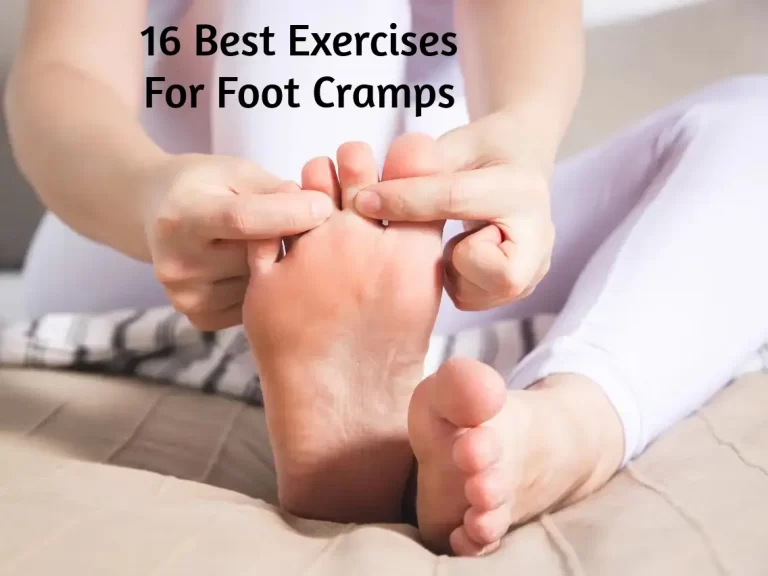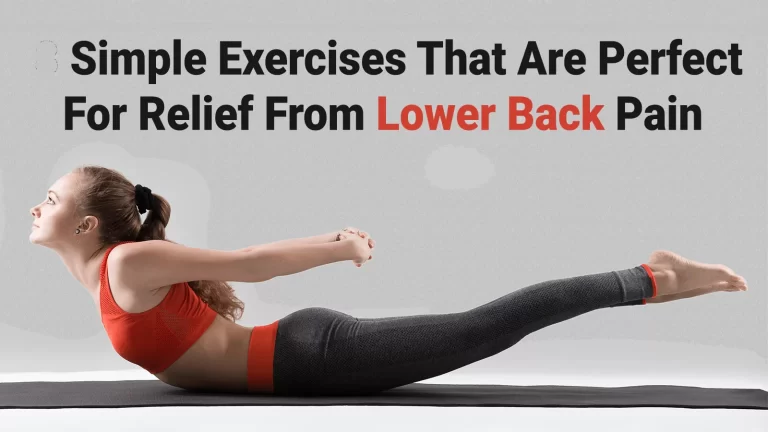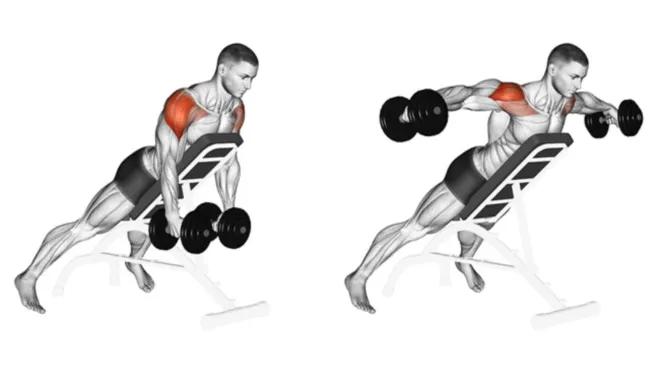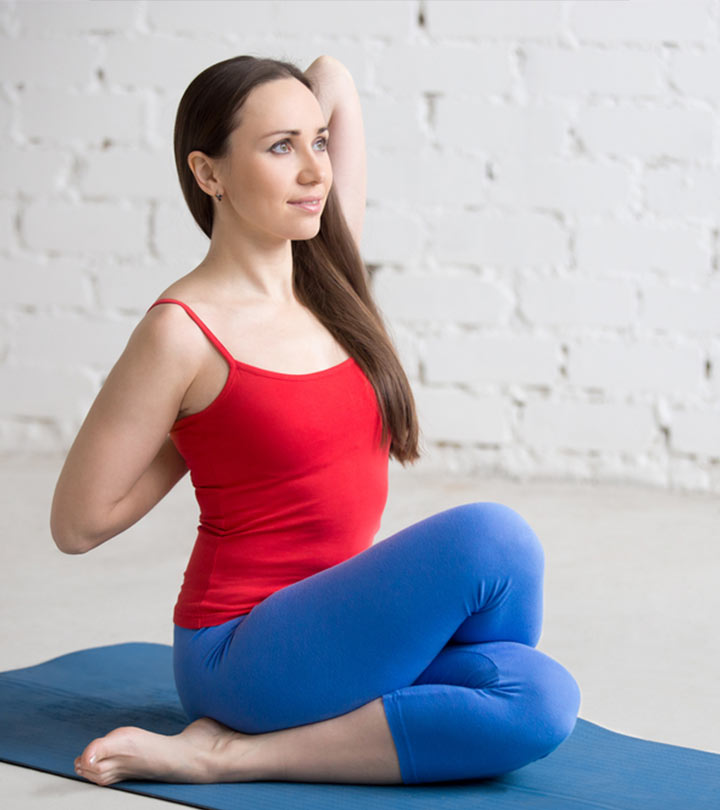Ankle Exercises: Health Benefits, How to do ?- Variation
What are Ankle exercises?
Ankle exercises is a great way to improve Ankle function and make your Ankle more powerful to perform all activity with ease.
The ankle joint is one of your main weight-bearing joints. Its function and structure make it prone to injury, especially during activities like jumping and running. After an ankle injury, as many as 30% to 70% of people will feel chronic ankle instability. This means the ankle becomes weaker and vulnerable to being injured again.
You can aid lower your risk of reinjury by strengthening and stretching your ankle after an injury. Working with a physical therapist (PT) may be the best way to aid you to regain normal use of your ankle. Your PT can assist you to choose the best ankle exercises for your condition. They can also guide you in your rehab and aid you gain ankle mobility and strength.
Anatomy of Ankle joint
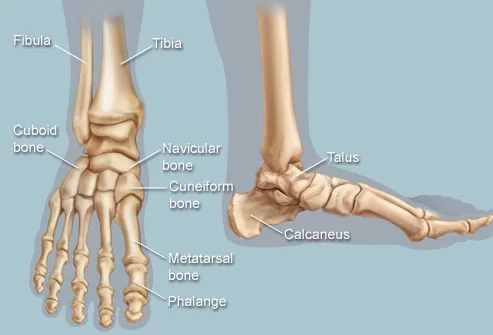
The ankle joint is a hinged synovial joint that is created by the articulation of the talus, tibia, and fibula bones. Together, the three borders from the ankle mortise.
The articular facet of the lateral malleolus creates the lateral border of the ankle joint
The articular facet of the medial malleolus creates the medial border of the joint
The superior portion of the ankle joint creates from the inferior articular surface of the tibia and the superior margin of the talus.
The talus articulates anteriorly with the navicular and inferiorly with the calcaneus.
The upper surface, known as the trochlear surface, is somewhat cylindrical and permits for dorsiflexion and plantarflexion of the ankle.
The talus is wider anteriorly and more narrow posteriorly.
It creates a wedge that fits between the medial and lateral malleoli making dorsiflexion the most stable pose for the ankle.
Many muscles cross the ankle joint, involving the gastrocnemius, soleus, flexor hallucis longus, posterior tibialis, and peroneal long is and brevis. Each muscle provides for both moving your ankle and stabilizing the ankle joint.
What are the Health Benefits of ankle exercises?
Some potential benefits of ankle exercises include :
Preventing injuries: Strengthening the muscles around the ankles aids reduce pressure on the ankle joint, which can help prevent injuries.
Improving bone density: Ankle exercises help increase bone density. An increased bone density decreases the risk of degenerative bone diseases, such as osteoarthritis.
Improving balance: Strong ankle muscles should improve balance. Good balance is essential to many sports and exercises. It will also decrease the risk of falls and injuries.
Improve range of motion of ankle joint.
It increases flexibility and mobility.
Some Ankle exercises related to some conditions
This exercise includes:
- Ankle Strengthening exercises
- Ankle exercises for Pain
- Ankle exercises for Sprain
- Exercise for Ankle Tendonitis
- Ankle Stability Exercises
- Exercise with Ankle Weights
Ankle Strengthening exercises
Below are some strengthening exercises for the ankle joint:
- Towel stretch
- Calf raise
- Towel curls
- Ankle alphabet
- Toe pull
- Standing heel raise
- Golf ball roll
- Heel Cord Stretch
- Heel Cord Stretch with Bent Knee
- Ankle Range of Motion
- Marble Pickup
- Ankle Dorsiflexion/Plantar Flexion
- Single leg balancing
- Single leg squats
- Single leg half circle taps
- Single leg floor touches “Oil Derrick”
- Isometric (No movement) Ankle Eversion
- Isometric (No movement) Ankle Inversion
- Plantar flexion with resistance band
- Dorsiflexion with resistance band
- Eversion with Resistance Band
- Inversion with Resistance Band
- Tibialis Posterior with Resistance Band
- Seated Soleus Raises
- Seated Toe Taps
- Weighted Soleus Raises – off the edge of a step
- Standing Calf Raises
- Weighted Calf Raises off the edge of a step
- Single leg Calf Raise
- Single leg Calf Raise off the edge of a step
- Toe splay
- Sand walking
Towel stretch

Sit with both legs extended in front.
Wrap a towel around the upper part of the foot, holding the towel at either end.
Gently pull the towel so that the toes turn toward the body.
Hold the pose for 30 seconds, and then release for 30 seconds.
Do the stretch 3 times, and then switch to the opposite side.
Calf raise
Stand on a slightly lifted platform, such as a step.
Keep the balls of the feet on the surface of the platform, allowing the heels to hang off the back.
Push up with the toes so that the heels lift above the surface.
Allow the heels to fall back down to just below the surface.
Do the stretch several times.
Towel curls
Sit with both feet flat on the ground.
Put a towel under one foot.
Curl the toes to grip the towel and raise it off the ground.
Pause it for a couple of seconds before releasing it.
Do with the opposite foot.
Ankle alphabet
Sit with one leg straighten out in front.
Put a pillow under the calf so that the foot hangs over the other side.
Utilize the big toe to draw the letters of the alphabet in the air.
Do the exercise several times on each side.
Toe pull
Sit in a chair and lift one leg off the ground, keeping it straight.
Gently point the toes back toward the body.
Hold the pose for a couple of seconds.
Release the toes and gently lower the leg back to the floor.
Do it several times with each leg.
Standing heel raise
Stand with your feet just wider than your shoulders.
Put the hands on the thighs and flex the knees slightly.
Raise one heel, keeping the toes on the ground, and then gently lower it back down again.
Do this exercise several times for each heel.
Golf ball roll

Sit on a chair and put a golf ball under the foot. Any ball of a similar size will perform.
Slowly rotate the foot up and down over the ball for a minute.
Repeat the exercise utilizing the other foot.
Heel Cord Stretch
Stand facing a wall with the unaffected leg forward with a slight flex at the knee. Your affected leg is extended and behind you, with the heel flat and the toes pointed in slightly.
Keep both heels flat on the ground and press your hips forward toward the wall.
Pause this stretch for 30 seconds and then relax for 30 seconds. Repeat.
Do not arch your back during motion.
Do 2 sets of 10 Repetitions.
Heel Cord Stretch with Bent Knee
Stand facing a wall with the unaffected leg forward with a slight flex at the knee. Your affected leg is behind you, with the knee flexed and the toes pointed in slightly.
Keep both heels flat on the ground and press your hips forward toward the wall.
Pause the stretch for 30 seconds and then relax for 30 seconds. Repeat.
Do 2 sets of 10 Repetitions.
Marble Pickup
Sit with both feet flat and place 20 marbles on the ground in front of you.
Utilize your toes to pick up one marble at a time and put it into a bowl.
Do it until you have picked up all the marbles.
Do 20 Repetitions.
Ankle Dorsiflexion/Plantar Flexion
Sit on the floor with your legs extended out in front of you.
For dorsiflexion, Tie the elastic band on a chair or table leg, then wrap it around your foot.
Pull your toes toward you and slowly back to the start position. Repeat 10 times.
For plantar flexion, wrap the elastic band around your foot and grasp the ends in your hand.
Gently point your toes and slowly return to the beginning position. Repeat 10 times.
Do 3 sets of 10 Repetitions.
Single leg balancing

Stand on a static surface on one leg.
Balance for 40-60 secs. And repeat.
Progress to standing on a pillow/couch cushion or do it with eyes closed.
Do 2-3 sets of 30-60sec. 1-2 times per day.
Single leg squats
Take a standing pose on a flat surface or cushion.
Slowly do a half squat to 45 degrees and hold 3 sec.
Back to starting position.
Do 2-3 sets of 15 reps. 1-2 times per day
Single leg half circle taps
Put 6 dots in a half circle 30 inches from the center.
Standing on one leg, slowly touch every dot with the other foot.
Can be done on a cushion/pillow to increase difficulty.
Do 3 sets of 30-60 sec. 1-2 times per day.
Single leg floor touches “Oil Derrick”
Stand on one leg with the knee slightly flexed.
Keeping upper body straight, slowly reach towards the ground.
Flex the knee while reaching forward.
Slowly return to starting position.
Do 3 sets of 15 reps. 1-2 times a day.
Isometric Ankle Eversion
While seated, put them outside of the symptomatic foot against a wall with a towel /pillow between your foot and the wall.
Push outwards with the foot into the wall (your ankle joint should not move) causing a contraction of the muscles on the outside of your lower leg.
Pause for 15-30 seconds.
Repeat 5 times.
Isometric (No movement) Ankle Inversion
While seated, put them inside of your foot against a table leg or inside of a door frame with a towel/pillow between your foot and
the table leg/door frame.
Push the foot in against the table leg (your ankle joint should not move too much).
Pause for 15-30 seconds. Repeat 5 times.
Plantar flexion with resistance band

Sitting in a chair with your leg extended in front of you. Loop the band around the foot.
Moving only your ankle, point the foot forward (while keeping your knee straight).
You may feel tightness in your calf muscle behind the lower leg. Continue until you experience discomfort or can’t move it any further.
Hold this pose for two seconds. Slowly return to the beginning position.
Do 12-20 times.
Dorsiflexion with resistance band
Set a looped resistance band around your foot and a heavy chair or table leg.
Moving only your ankle, pull the toes back towards your shin (while keeping your knees extended). Do it until you feel discomfort or can’t move it back any further.
Hold this pose for two seconds and slowly release.
Return to the beginning position, and then repeat the exercise.
Do 12-20 times.
Eversion with Resistance Band
Sitting on a chair with your feet on the ground. Wrap the resistance band around both feet whilst grasping both ends of the band in your hands.
Try to move the symptomatic foot up and outwards against the resistance of the band.
Hold for 1-3 seconds then slowly control the ankle back to the beginning position.
Make sure only your ankle is moving and not the entire leg.
Repeat 6-12 reps.
Inversion with Resistance Band
Set the looped resistance band on your symptomatic foot whilst grabbing the band in one hand out to the side.
Try to move your affected foot down and inwards against the resistance of the band.
Pause for 1-3 seconds then slowly control the ankle back to the starting position.
Make sure only your ankle is moving and not the entire leg.
Repeat 6-12 reps.
Tibialis Posterior with Resistance Band
Put a resistance band around your forefoot. Place two little markers down (e,g tape or pens) as a guide to where your foot will move to and from. Anchor the band to a heavy table or chair leg or hold it out to the side away from the body.
Keep your foot on the ground and move your foot between the two pieces of tape. Try to keep the upper leg still during this exercise.
Repeat 6-12 reps.
Seated Soleus Raises
Sit down with your knees flexed to 90 degrees right angle with your feet flat on the ground.
Lift your heels up and down as quickly as comfortable.
Rest.
Seated Toe Taps
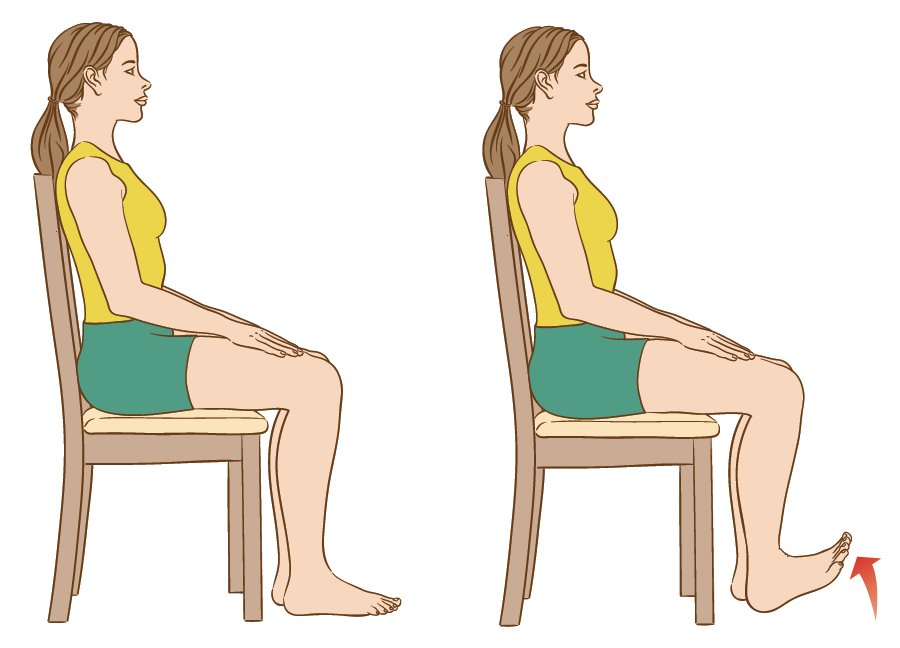
With your feet flat on the ground.
Now do a tapping motion with each foot.
Lifting your toes up and down.
Do each exercise for 30-60seconds.
Do 4-5 times a day as able.
Weighted Soleus Raises – off the edge of a step
Sitting down with your knees flexed to 90 degrees right angle with your forefoot on the edge of a step/book or equivalent.
Put a weight / heavy box/books or equivalent on your knees.
Push up on the toes as far as you can Comfortably.
Pause for 2 seconds at the top of the motion.
Slowly return to the beginning position.
Do 10-15 reps.
Standing Calf Raises
Grabbing onto a chair for support.
Push up on the toes in Standing.
Pause for 2 seconds at the top of the motion.
Slowly return to the beginning position.
Do 10-15 reps.
Stand on edge of stairs or steps.
Do a calf raise lifting your heels as far as you can comfortably, and pause for 2 seconds at the top of the movement.
Slowly lower down to the beginning position.
Do 10-15 reps.
Weighted Calf Raises off the edge of a step
Do standing on edge of a step or stairs.
Grab a weight in one of your hands, and hold onto the wall/banister with your other hand for balance.
Do a calf raise lifting your heels as far as you can comfortably, and hold for 2 seconds at the top of the motion.
Slowly lower down to the beginning position.
Repeat 10-15 reps
Single leg Calf Raise

Stand on the ground holding onto a chair/kitchen work surface.
Lift one leg so it’s off the floor.
Then do a single leg calf raise lifting your heel off the floor, and pause for 2 seconds at the top of the movement.
Slowly lower down to the beginning position.
Do 6-8 reps.
Single leg Calf Raise off the edge of a step
Stand with one leg on the edge of stairs or steps. The other leg you are not working on can either be raised out to the side or tucked behind your other ankle.
Do a single leg calf raise lifting your heel as far as you can comfortably, and pause for 2 seconds at the top of the movement.
Slowly lower down to the beginning position.
Do 6-8 reps.
Single leg Balance
Stand on one leg trying to balance gripping your toes into the floor.
Grab onto a chair or work surface with fingertips if required.
Perform this as often as you can throughout the day e,g washing up, brushing teeth, waiting for the kettle to boil, making tea, at work whenever you get the opportunity.
Do 6-8 reps.
Toe splay
Performing the toe splay exercise can improve control over the toe muscles. People can perform it on both feet at once or on alternate feet, depending on which they find more comfortable.
Sit in a straight-backed chair, with the feet gently resting on the ground.
Spread the toes apart as much as possible without straining. Hold this pose for 5 seconds.
Repeat this movement 10 times.
Once a person has improved their strength, they can try looping a rubber band around the toes. This will give resistance and make the exercise more challenging.
Sand walking
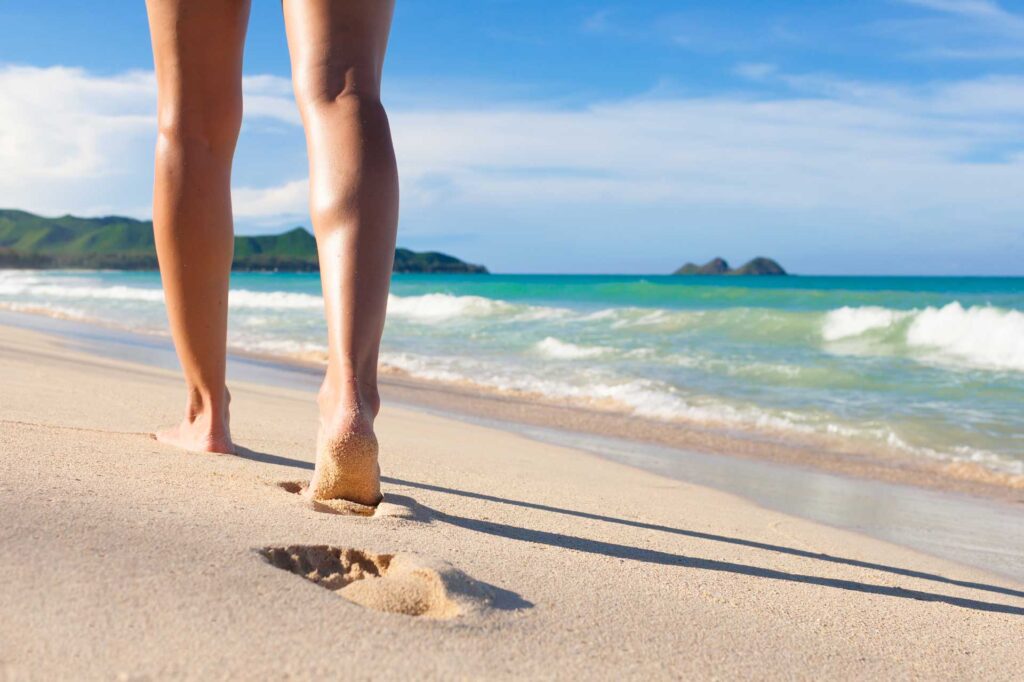
Walking barefoot on sand is the best way to stretch and strengthen the feet and calves. This is the best exercise in general because sand’s soft texture makes walking more physically demanding.
Head to a beach, a volleyball court, a desert, or any other location with sand.
Remove the shoes and socks.
Walk for as long as possible. Try increasing the distance slowly over time to prevent overexerting the muscles in the feet and calves.
Ankle exercises for Pain
There are some pain relieving exercises for the ankle joint:
- Calf Stretch with Strap
- Wall Push-offs
- Ankle ABCs
- Split Stance Weight Shifting
- Rainbow Roll outs with Tennis Ball
- Arch Roll outs with Tennis Ball
- Fingers between Toes
- Toe Lifts
- Ankle Stretch
- Ankle Flexion
- Heel Slides
- Ankle Rotations
- Sitting plantar fascia stretch
- Towel pickup
- Toe bend
- Deep calf stretch
- Toe extension
- Golf ball roll
- Seated ankle circle or alphabet
- Cross-leg ankle stretch
- Seated heel and toe raise
- Self ankle mobilization
- Standing calf stretch
- Standing soleus stretch
- Towel stretch
- Inward band stretch
- Outward band stretch
- Chair Pose
Calf Stretch with Strap
Begin seated on the edge of the chair with a yoga strap (or long belt) in hand.
Extend your left leg and loop the strap under the ball of your foot. Keep your heel on the ground, knee slightly bent.
Using the strap, gently pull your toes towards you until you experience a stretch through your calf. Pause 1-3 seconds and release. Do it 10 times.
Take it deeper:
Utilize the strap to pull your toes toward you, leading with the big toe and turning the ankle slightly inward. Pause 1-3 seconds and release.
Utilize the strap to pull your toes toward you, leading with the pinky toe and turning your ankle slightly outward. Pause 1-3 seconds and release.
Do 5 times each side.
Change legs and repeat on the right side.
Wall Push-offs

Take a standing pose one foot away and facing the wall. Toes pointed straight ahead.
Keeping your heels anchored on the ground, lean forward towards the wall. Catch yourself with your hands.
Push off the wall to back to standing.
Do it 20 times.
To increase the intensity of the stretch, back away from the wall until you reach a distance where you experience a strong stretch in your calves when you’re leaning forward against the wall. Be sure to keep your heels down during the exercise.
Ankle ABCs
Begin seated on the edge of your chair, feet planted firmly on the ground.
Raise your left foot.
Trace the ABCs in the air (all capital letters) with the toes. Draw the letters as big as possible.
Use your ankle for the movement, not your knee or hip.
Split Stance Weight Shifting
Begin standing one foot away and facing the wall. Put your hands on the wall in front of you for balance.
Take a big step back with your right leg, keeping your left foot forward. This is known as a “split stance”.
Push your hips forward to transfer your weight into the front leg, flexing your front knee and keeping your heel on the floor. Keep the back leg straight. Pause 1-3 seconds.
Pull your hips back, transferring your weight back into the back leg, bending at the knee. Your front leg straightens and the toes of your front foot come off the ground, pulling up towards your knee. Pause 1-3 seconds.
Rock back and forth (between steps 3 and 4) so you’re transferring your weight from the front leg to the back leg. Perform this 10-15 times.
Switch legs and do this steps 3-5.
Rainbow Roll outs with Tennis Ball
Begin seated on the edge of your chair, feet firmly planted on the ground.
Place the tennis ball on the ground under the ball of your left foot.
Keeping your heel on the ground, make a rainbow with your toes over the tennis ball by rolling your foot left to right. Goal to touch your big toe to the mat, then rotate and touch the pinky toe to the mat.
Do it 10 times.
Switch feet and do this steps 3 & 4.
Arch Roll outs with Tennis Ball
Begin standing next to the wall (to use for balance as needed).
Place the tennis ball on the ground under the ball of your left foot.
Applying gentle pressure, slowly roll the ball from the base of the heel up to the ball of your foot, massaging out the arch of the foot.
Do it 10-15 times.
Switch feet and do steps 3 & 4.
Fingers between Toes
Begin seated on the edge of your chair, feet firmly planted on the floor.
Cross your right leg over your left in a figure-4 position.
Using your left hand, gently slide your fingers between your toes. You should experience a nice stretch.
Gently move the foot up and down 5-10 times.
Make slow circles clockwise 5 times, and counterclockwise 5 times.
Repeat for as long as you’d like, allowing your toes to relax slowly.
Switch feet and do this steps 3-6.
Toe Lifts
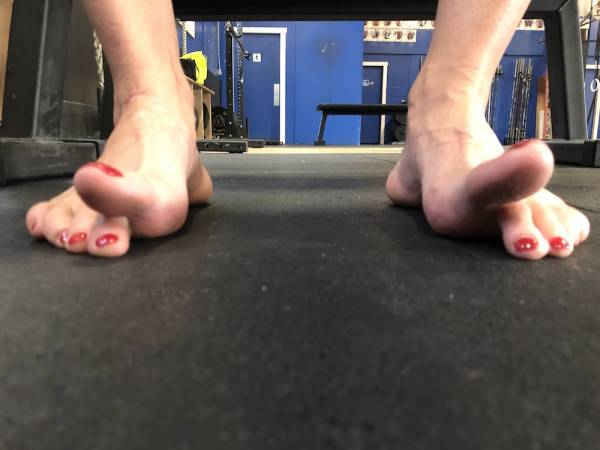
Begin standing with a chair behind you for safety.
Lift only your big toes off the mat. Do it 10-15 times.
Leave your big toe anchored and raise the other 4 toes off the mat. Do it 10-15 times.
Raise all 10 toes off the matt. Repeat 10-15 times.
Take it deeper:
Raise all 10 toes off the mat.
Slowly sit down into the chair and then stand back up, keeping toes raised the entire time.
Do it 10-15 times.
Ankle Stretch
Place one end of a Sportcord over your left foot at the instep (not the tip of the shoe).
Extend your left leg and pull up the Sportcord until you have the desired resistance and difficulty.
Extend your left toe downward, as if you are pressing on the gas pedal in the car.
Pause extended for five seconds, and then repeat twenty times.
Switch legs and repeat with the right foot.
Ankle Flexion
Sitting on a chair with right leg extended.
Flex top of toe backward, and pause for 20 seconds.
Relax, and do it 10 times.
Heel Slides
Lie on the ground and slide your left heel up towards your buttocks as far as comfortable then slide back down.
Do it 10 times with each leg.
Ankle Rotations
Lift your foot about 20 inches off the floor.
Then with your toe upward, rotate the foot to the right and then back to the left.
Pause for 10 seconds then return to starting position.
Do it 20 times for each leg.
Sitting plantar fascia stretch
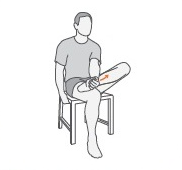
Cross the foot over the opposite knee.
Hold the base of the toes and slowly pull back until you feel a stretch along the underside of your foot.
Pause for 15-20 seconds per repetition.
Do it 3 times on each foot.
Towel pickup
Place a towel on the ground in front of your chair.
With your heel on the floor, pick up the towel by grabbing it with your toes.
Do it 10-20 times.
This exercise can be modified by adding a small weight to the towel.
Toe bend
Place your heels on the ground with your toes pointing in the air in front of you.
Flex your toes downwards and hold for a few seconds, then relax.
Next, flex your toes upwards and hold for a few seconds before relaxing.
Do it 5 times.
Deep calf stretch
Stand on a step with the heel hanging off the edge.
You may want to grab onto something for support.
Permit your heels to drop towards the ground and feel a stretch in the calf muscles and Achilles tendon.
Pause for 20 seconds.
Do it 3 times.
Toe extension
Sit up straight in a chair, with the feet flat on the ground.
Place the right foot on the left thigh.
Pull the toes up toward your ankle.
There should be a stretching feeling along the sole and heel cord.
Pause for 10 seconds. Massaging the arch of the foot while stretching will aid ease tension and pain.
Practice this exercise 10 times on each foot.
Golf ball roll
Sit up straight in a chair, with the feet flat on the ground.
Set a golf ball — or another small, hard ball — on the ground next to the feet.
Place one foot on the ball and move it around, pressing down as hard as is comfortable.
The ball should be massaging the sole.
Continue for 2 minutes, then repeat utilizing the other foot.
Cross-leg ankle stretch
Sit in a chair and cross your right leg over your left knee.
Grab the top of your right foot with both hands.
Use your hands to bend your right toes and ankle downward until they make a point. (You should experience the stretch in the front of your ankle and foot.)
Pause for 30 secs, then switch your leg position and repeat.
Seated heel and toe raise
Sit in a chair with your feet flat on the ground.
Lift both heels a few inches off the floor. Pause for a few secs.
Lower your heels back down.
Raise toes off the ground. Pause for a few secs.
Lower your toes back down.
Perform both moves at least 5 times.
Self ankle mobilization
If stiff ankles are a problem, this move can aid.
Stand near a wall or another support, like a static chair. Keep the hands on the wall at eye level.
Put your right foot a step behind your left foot.
Keep right heel on the floor. Bend the left knee until you feel a stretch in the right leg.
Bend your right knee a bit to stretch your Achilles tendon.
Pause for 15–30 secs. Do 2–4 times on each leg.
Standing calf stretch
Stand facing a wall or another support, like a static chair, with one foot about 12 inches in front of you.
Point the toes up (try propping your front toes on a yoga block, wall, or chair leg).
Time to lean, rock with it: Slowly lean forward until you experience the stretch in the back of your calf and ankle.
Pause for 30 secs, then repeat on the other side. Perform 3 sets.
Standing soleus stretch
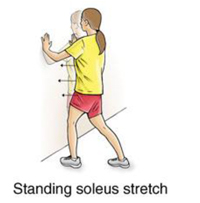
Stand a few feet from a wall or another static support, like a chair.
Step one foot a couple of feet back, heel flat on the ground.
Step your opposite foot forward, toward the wall or chair.
Gently turn your back ankle inward toward the opposite foot and gently flex your back knee.
Slightly flex the front knee until you feel a stretch in the back calf and ankle.
Pause for 30 secs and repeat 3 times.
Towel stretch
Grasp a towel and sit on the ground with your legs out in front of you.
Loop a towel around your toes on both feet (a yoga strap or resistance band will also work well).
Pull back slightly until you begin to feel a stretch in the soles of your feet and the backs of your calves.
Pause for 30 secs and repeat 3 times.
Inward band stretch
Sit with legs extended. Wrap the band around your right foot.
Grasp both ends of the band.
Slowly turn your right ankle inward, so your sole starts to turn toward the right.
Pull up on your right side of the band to deepen the stretch.
Pause for 30 secs. Repeat 3 times on each leg.
Outward band stretch
Sit with legs extended and the band around your left foot.
Grasp both ends of the band.
Slowly turn your left ankle outward, so your sole starts to turn toward the left.
Pull up on your left side of the band to get deeper into the stretch.
Pause for 30 secs. Do 3 times on each leg.
Chair Pose
Stand upright and tall, feet hip-width apart. Inhale and lift both arms overhead, palms inward.
Exhale and flex both knees slightly until your thighs are parallel with the floor. Your upper body and the tops of your thighs should make a right angle.
Pause for 30 secs to a minute. Come out of it by inhaling and straightening the legs. Do it at least 3 times.
Ankle exercises for Sprain
There are certain ankle exercises for ankle sprain:
- Ankle alphabet
- Knee motion
- Towel and tissue scrunches
- Towel stretch
- Standing calf stretch
- Heel raise
- One-leg balance
- Elastic band push
- Elastic band pull
- Ankle out
- Ankle in
- Balance with eyes closed
- Pillow balance
- Pillow balance with eyes closed
- Ankle circles
- Drawing or writing with the ankle
- Towel curls
- Band pushes
- Wall pushes
- Calf stretch
- Standing calf stretch
- Standing Soleus muscle stretch
- Resisted dorsiflexion
- Resisted Plantar flexion
- Resisted inversion
- Resisted eversion
- Single leg heel raise
- Toe raises
- Wobble board
- Ankle Active Plantar flexion and Dorsiflexion
- Towel Stretch with Knee Bent
- Heel-to-Toe Walk Exercise
- Toe Walks
Ankle alphabet

Take a sit on a couch or comfortable chair.
Straighten your leg out and trace the letters of the alphabet in the air with your big toe.
If there’s no pain, you can perform this 2 or 3 times.
This gentle exercise aids you to move your ankle in all directions.
Knee motion
Sit in a chair with your foot flat on the floor.
Keeping your foot on the ground, slowly move the knee from side to side for 2 to 3 minutes.
This stretches and relaxes the ligaments around the ankle.
Towel and tissue scrunches
Place a small towel on the ground in front of you while you sit in a hard chair.
With your shoes and socks off, gently grasp the towel with your toes, scrunch it up, and count to 5.
Then let go of the towel and repeat. Perform this 8 to 10 times— or less if you feel pain.
You can also attempt this with a tissue.
Towel stretch
Sit on the ground with your leg stretched out in front of you.
Wrap a towel or strap around the ball of the foot.
Pull back on the towel so the toes move toward you.
Pause the stretch for 15 to 30 seconds.
Don’t overperform it. You only need to experience a mild to moderate stretch on your calf muscle.
Standing calf stretch
Stand facing a wall or in front of a countertop and place your hands on it for support.
Put your injured ankle about one step back and your good foot forward.
Keeping your back heel flat on the ground, slowly flex the knee of your good leg until you feel a moderate stretch in the calf on your injured side.
Do this 3 times, holding for 30 seconds.
Heel raise
Stand with the hands in front of you, resting against a wall, countertop, or chair back for support.
With the feet shoulder-width apart, gently rise on your toes and come back down.
Perform about 10 of these at first and work up to 20 or more.
Remember, you only need a moderate stretch and no pain.
When these become easy, you can switch to performing it only with the toes on your injured side.
One-leg balance
With your hands on a wall, countertop, or chair back, raise your good leg behind you so that your weight rests on the leg with the injured ankle.
Try to pause this for 20 to 30 seconds.
As you get stronger, try performing it only with the support of one or two fingers.
When you’re stronger, perform this without holding on.
Elastic band push
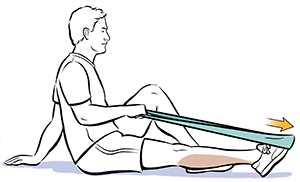
This is a modification of the towel stretch, but with resistance.
Sit on the ground. Prop up your ankle with a rolled-up towel or swimming noodle to keep your heel off the ground.
Set the elastic band around the ball of your foot and hold the two ends.
Now gently push your ankle forward like you’re pointing your toe.
Then gently bring it back. Repeat this 10 times. Don’t utilize the band if there is any pain, or if your ankle feels wobbly.
Elastic band pull
Anchor your resistance band around a heavy object such as a desk or table leg.
While sitting on the ground, hook your toes and upper foot into the band.
Now, slowly pull the foot back towards you and return it to a vertical position. Do this 10 times.
Ankle out
Method 1: Anchor your resistance band around a heavy object.
Sit or stand and hook the inside of the foot into the end of the band.
Slowly move the foot to the outside and back. Do it 10 times at first, and build up to 20 times.
Method 2: You can also perform this while sitting down with your ankle propped up on a rolled towel or noodle.
Anchor a loop at the end of the resistance band and hook it around your foot.
Now arrange the band to also go around the good foot.
Your good foot acts as a pivot. Grabbing onto the end of the band, turn your ankle out. Do 10 times at first, and build up to 20 times.
Ankle in
With the resistance band loop around a heavy object, hook the inside of the foot into the band.
Now slowly move the foot inward against the resistance band and bring it back.
Do 10 times, and build up to 20 times.
Balance with eyes closed
Now repeat the basic balance exercise with the eyes closed.
This is much harder because you don’t have visual points of reference to aid your balance.
Assure to have something for support.
Again, try to do it up to 30 seconds and 1 minute, if you can.
Pillow balance
Perform the same basic balance exercise while standing on a pillow.
This is much harder. Even if the ankle isn’t sprained, your foot will wobble around a lot and you’ll constantly require to correct your balance.
See if you can do up to 30 seconds to 1 minute. Stop if you begin to feel pain in the ankle.
Pillow balance with eyes closed
This is a very challenging exercise.
See how long you can hold the balance while standing on a pillow with your eyes closed.
Assure to have something available for support.
Perform up to 30 seconds to 1 minute if you can.
Ankle circles

One simple range of motion exercise includes making clockwise and counterclockwise circles with the foot and ankle.
To perform this exercise, sit in a comfortable chair or on the couch, holding the foot off the floor.
Start by slowly making large circles, clockwise, with your foot and ankle.
Do 10 repetitions and then repeat moving counterclockwise.
Drawing or writing with the ankle
Another effective range of motion exercise includes drawing or writing letters, numbers, or other characters with the foot.
To perform this exercise, sit in a comfortable chair or on the couch, holding the foot off the floor.
Trace every letter of the alphabet in the air with the foot, utilizing the big toe as a cursor or pencil.
If this exercise does not start pain, repeat the full alphabet three times.
Towel curls
Sitting on a hard chair, such as a kitchen chair, put a hand towel on the ground in front of the chair.
With bare feet, utilize the toes to grab the towel.
Pause this position for 5 seconds and release.
Perform this action 10 times if it does not cause pain.
Another form of this activity is to utilize the foot to pick up marbles from the ground and put them in a cup.
Band pushes
Sit flat on the ground with the legs in front of the body.
Put a resistance band or towel around the ball of the foot.
Push against the band so that your toes point slightly forward. Do this 10 times.
Wall pushes
Sit on the ground with the feet straight in front of the body, resting against the wall.
Flex the other leg and push against the wall with the healing leg.
Pause this position for 6 seconds before relaxing. Do it 10 times.
Calf stretch
Physically stretching out the ankle utilizing a towel, band, or another object may help increase flexibility.
Sit on the ground with the legs directly in front of the body.
Put a towel or band around the balls of the feet and pull the feet back gently so that the toes point toward the body.
Do this without flexing the knees, which should cause a mild stretch in the calf muscles and back of the leg.
Pause the stretch for 30 seconds if it does not cause pain.
Standing calf stretch
Put the hands on a wall in front of the body at about eye level.
Take one step back with the healing leg.
Keeping the healing foot flat on the ground, flex the other leg at the knee gently, feeling a stretch in the calf.
Pause for 30 seconds.
After this, repeat the same action, but this time slightly flex the back knee.
This will stretch a different part of your calf. Pause for 30 seconds.
Do the process three times.
Standing Soleus muscle stretch
Stand facing the wall with the hands on the wall.
Keep your knees a little flexed and the sore foot back.
Gently lean the knees in towards the wall to stretch the back of the calf.
Keep your heel on the floor.
Pause for 30 seconds and repeat 3 times.
Resisted dorsiflexion
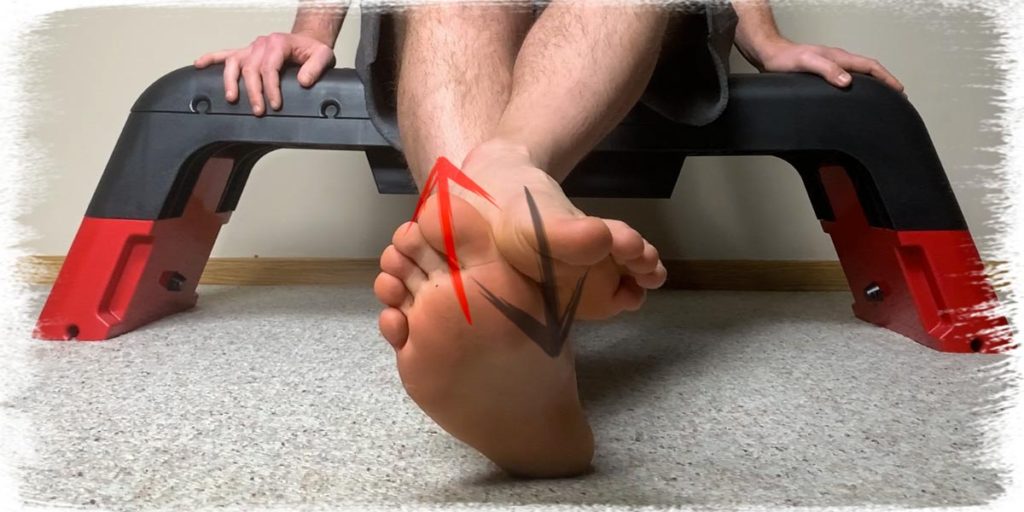
Put your injured foot under your good foot.
Put the heel of your good foot on top of the toes of the injured foot.
Gently pull the toes and ankle towards your face on the injured ankle and the good foot can give resistance on top.
Pause for 5 seconds. Do it 10 times. Perform 3 sets of 10 exercises.
Resisted Plantar flexion
Put your injured foot on top of your good foot.
Push down to the ground and your good foot can provide resistance to the motion.
pause for 5 seconds and repeat 10 times. Perform 3 sets of 10 exercises.
Resisted inversion
Hold the feet together and push them together.
The good foot can give resistance to the movement of the injured foot.
Pause for 5 seconds and repeat 10 times. Perform 3 sets of 10 exercises.
Resisted eversion
Cross your legs over with the ankles crossed.
Then push the outsides of the feet together.
The good foot will resist the motion of your injured ankle.
Pause for 5 seconds and repeat 10 times. Perform 3 sets of 10 exercises.
Single leg heel raise
Stand without any support and attempt to balance on your injured leg.
Start with your eyes open and then try to do the exercise with your eyes closed.
Pause the single-leg position for 15 seconds. Do 3 times.
Toe raises
Rock back on the heels so that your toes come lift off the floor.
Pause this position for 5 seconds. Do it 10 times. Perform 3 sets of 10.
Wobble board
This exercise is important to regain balance and coordination with your ankle.
Start balancing on both legs, then on the injured leg.
Perform this for 5 minutes 3 times a day.
You may need to Grab onto a chair or table for balance.
Ankle Active Plantarflexion and Dorsiflexion
Ankle motions in a forward and backward direction is an important exercise to aid maintain and improve your range of motion after an ankle sprain. You can perform this exercise either sitting or lying.
To perform this exercise – begin by slowly pointing your toes away from you as pain allows.
Then slowly pull the toes back up towards you as pain allows. Do this 20 – 30 repetitions.
Perform this exercise every 2 hours as pain allows.
Towel Stretch with Knee Bent

Sit on the ground or top of your bed.
Flex the leg with the injured ankle in front of you with the heel resting on the surface you are doing the exercise on.
Wrap a towel around the ball of the foot, this is just below the toes.
Pull back on the towel slightly until you begin feeling a stretch deep in the back of the lower leg.
The goal is to hold the stretch for 30 seconds.
Do this 3 times, 4 times per day
Heel-to-Toe Walk Exercise
Keep your eyes facing forwards and not looking at the feet.
Pretend you’re walking on a tightrope by putting one foot directly in front of the other.
Perform 4 meters and turn.
Toe Walks
Keep your eyes facing forwards and not looking at the feet.
Shift your weight on the balls of each foot and then walk forwards.
Perform 4 meters and turn.
Exercise for Ankle Tendonitis
Below are some exercises for Ankle Tendinitis:
- Towel stretch
- Standing calf stretch
- Heel raises
- Plantar fascia stretch
- Ankle flexion
- Standing soleus stretch
- Eversion and inversion
- Seated Ankle Stretch
- Heel Cord Stretch
- Standing Heel Raises
- Hamstring Stretches
- Golf Ball massage
Towel stretch
To do this stretch, a person will require a bath or pool towel.
Sit on the floor with the feet straight out in front.
Take the towel and loop it around the toes of one foot.
Gently pull back until a stretch runs from the sole up to the back of the lower leg.
Pause this stretch for 30–60 seconds.
Switch to the opposite leg and repeat.
A person should perform this exercise 2–3 times on each side.
Standing calf stretch
The standing calf stretch needs a sturdy closed door or a blank wall.
Stand facing the wall or door and put the palms against it, slightly higher than the shoulders.
Step back into a split stance, keeping both feet flat on the floor with the toes pointing forward.
Slowly lean forward and flex the front knee to feel a stretch in the lower part of the back leg.
Pause the position for up to 30 seconds.
If a person is not feeling the stretch, they can try flexing the back knee slightly while pushing the heel into the ground.
A person should do this exercise 2–3 times on each side.
Heel raises

A chair, counter top, or table is needed for this exercise.
Stand behind the chair, counter top, or table and grab onto it for support.
Rise onto the toes and hold the pose for 5–10 seconds.
Releasing the support, lower the heels down slowly.
If necessary, when lowering down, keep grabbing the support for balance.
People can do this exercise 5–10 times.
Plantar fascia stretch
A person will require to sit on a chair for this stretch. They will also need either a foam roller, tennis ball or food can.
Sit on the chair and put the foam roller, tennis ball, or food can under one foot.
Roll the foot back and forth over the object for 60 seconds. Then do the same on the opposite foot.
Then, cross one leg over the opposite, hold the big toe of the crossed leg, and slowly pull it toward the body.
Pause this for 30–45 seconds.
Switch the legs over and repeat this motion.
A person should perform this cycle of stretches 2–3 times.
Ankle flexion
To perform an ankle flexion, a person will require a resistance band.
Sitting upright on the ground, place the resistance band around the ball of one foot and then straighten that leg out in front.
Point the toes on the extended leg away from the body, then slowly bend the ankle by pulling the toes toward the shin.
Repeat the motion up to 10 times.
Repeat the exercise on the opposite leg.
Standing soleus stretch
Take a standing pose a few feet away from a wall and face the wall.
Your injured leg should be back with your heel on the ground. Bring the other leg forward, toward the wall.
Turn your injured foot slightly inward toward the opposite leg.
Keep your other leg forward and slightly flex that knee and lean into the wall until you feel a stretch on your affected leg.
Pause for 30 seconds and repeat three times.
Eversion and inversion
Sit on a chair with the affected leg crossed over your opposite knee.
Holding the end of the foot with your hand, slowly tilt the sole of your foot toward the ground.
Hold this pose for 5 to 10 seconds and then pull your foot toward you, tilting it to the roof. Do it 10 times.
Seated Ankle Stretch
Sitting on a chair, scoot the bottom forward to the edge.
Stretch your legs out in front of you and plant your heels on the ground.
Point the toes of the injured ankle up towards the shins, as high as you can.
Hold this pose for 15 to 30 seconds.
Repeat three to five times; then change sides.
Heel Cord Stretch
Stand facing a wall.
Place your hands on it and step back with the left ankle. Both heels should be flat on the ground.
Point the toes of the left ankle in slightly.
Straighten your back knee and flex your front knee towards the wall.
You should feel a stretch in your left ankle. Pause for 30 seconds.
Finish two sets of 10 reps on each side.
Standing Heel Raises
Start standing on the floor.
Point your toes and lift your heels off the ground as high as you can, flexing your calf muscle.
Slowly lower yourself back down to the floor.
Do 20 to 25 reps.
Hamstring Stretches

Choose a large bath towel.
Wrap the towel around the toes of the leg you are stretching.
Lie down and raise the stretching leg while pulling on the towel.
Your other leg should lie flat and the leg being stretched should be straight.
Pause this stretch for 30 seconds for 3 sets.
Perform regularly.
Golf Ball massage
Sit tall with your feet flat on the ground.
Put the golf underneath the arch of your foot.
Give firm pressure by putting weight through your foot into the golf ball.
Gently roll the ball forwards and back on the sole while keeping firm pressure.
Perform this for 1-2 minutes as tolerated.
Perform this 3 times a day.
Ankle Stability Exercises
There are some Ankle Stability exercises:
- Single-leg Balance
- Single-Leg Balance with Movement
- Toe-Heel Walking
- Single-leg Step Downs
- Walking Lunges
- Single-leg Roman Dead lifts
- Partial Weight-Bearing Seated Calf Raises
- Partial Weight-Bearing Standing Weight Shift
- Full Weight-Bearing Standing Calf Raises
- Full Weight-Bearing Lateral Stepping
- Full Weight-Bearing Lateral Jump
- Single Leg Stance on a Towel
- Balance with eyes closed
- Pillow balance
- Pillow balance with eyes closed
- Non-weight-bearing Ankle motion
- Isometrics exercises
Single-leg Balance
Stand up with legs directly under the body or as they feel best naturally.
Transfer your weight from both feet onto one foot. (If you feel unstable, utilize a chair to prop against until you build strength).
Pause for a few seconds at least, adding time as you improve.
Transfer legs and repeat.
Do each set.
As you improve, you can raise your non-weight-bearing leg off the ground more and more, or stand on unsteady surfaces, like a BOSU ball for an added challenge.
You can also simply increase the amount of time you hold the position.
Single-Leg Balance with Movement
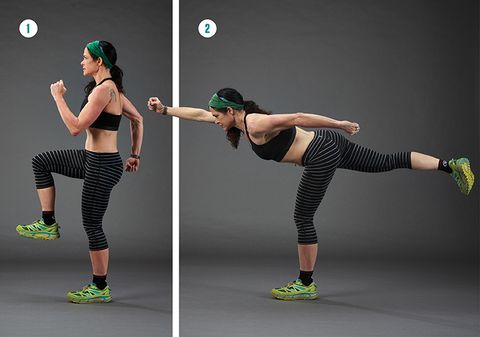
Stand up with your legs directly under the body as they feel the most natural.
Transfer your body weight from both feet onto just one foot.
Raise the leg without weight on it off the floor, slowly.
Instead of keeping your raised leg still, like the single-leg balance mentioned above, move your leg.
Swing it back behind the body and then in front, flex your knee and lift it towards your waist and then back down. Or, send your leg out towards the side of the body and then back in. Perhaps, perform all three in sequence.
If you are unsteady because of the motion, use a chair for added support, just like you did in the original single-leg balance. Eventually, you will be able to perform this pose unaided.
Toe-Heel Walking
Stand up.
Transfer your body weight to the back of the feet.
Make sure the front part of your foot is elevated off the ground.
Balance on the heels, then walk.
Keep this up for a few seconds at least between breaks. The goal is for 8 sets of 15 to 20 seconds with 20 seconds rest between them.
Change your body weight to your toes (or as close as you can get).
Start walking on your toes.
Keep this up for a few seconds at least between breaks.
Try to finish this routine twice a day and aim to increase the duration as you gain strength back in your ankles.
Single-leg Step Downs
Stand on a stable, elevated surface, such as a step, box, or bench.
Hold one foot off the edge.
Flex the knee of your supporting leg.
Bring the foot back up to its elevated pose.
Drive your weight through the heels.
Repeat 15 times on each side of the body.
Walking Lunges
Stand up.
Take one step forward and flex this leg until your knee is at a 90-degree angle.
Let your back knee dip down to the floor.
Hold this pose for a few seconds.
Utilize the leg in the back to step in.
Repeat on the opposite leg.
Single-leg Roman Dead lifts

Stand up with a resistance (preferably a kettlebell) in one hand.
Slowly flex at the waist, maintaining control of your body.
Lower the weight down towards the ground (using one hand) while you lift your leg (on the same side of your body) off the ground.
Slowly back to a standing position.
Do it ten times on each side of your body.
Partial Weight-Bearing Seated Calf Raises
Sit in a chair with the injured foot on the floor.
Raise your heel as far as possible while keeping your toes on the ground.
Return your heel to the ground.
Partial Weight-Bearing Standing Weight Shift
Stand upright while grabbing onto a stable object.
Transfer some of your weight onto the injured foot.
Pause the position for 15 seconds.
Then, relax and place your weight back onto your uninjured foot.
Full Weight-Bearing Standing Calf Raises
Stand on the injured foot while raising the uninjured foot off the ground.
Lift yourself, standing only on the ball of the injured foot and lifting your heel off the floor.
Hold the pose for 15 seconds.
Relax and place your weight back onto your uninjured foot.
Full Weight-Bearing Lateral Stepping
Place a rolled towel or short object on the floor to the side of your injured foot.
Step over the towel with the injured foot and stay on that foot.
Then draw the uninjured foot over the object and stand on both feet.
Step back over the towel with the uninjured foot and stay on that foot.
Then draw the injured foot back over the towel and stand on both feet.
Full Weight-Bearing Lateral Jump
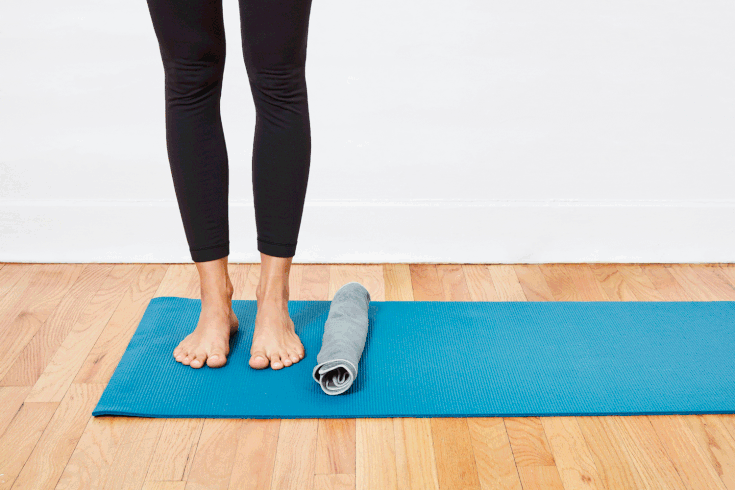
Put a rolled towel or short object on the ground to the side of your injured foot.
Jump over the towel and land on the injured foot.
Then jump back over the towel and land on the uninjured foot.
Single Leg Stance on a Towel
Fold a towel into a small rectangle and place it on the floor.
Stand with the injured foot over the towel.
Lift the uninjured leg off the floor. Stand only over the towel with the injured leg.
Pause for 15 seconds. As your balance improves, rise that time up to 45 seconds.
Return your uninjured foot to the ground.
You can increase the challenge by standing on more unstatic surfaces like a wobble board. Your PT may also have you utilize a BAPS board (Biomechanical Ankle Platform System) while working on balance exercises.
Balance with eyes closed
Now repeat the basic balance exercise with the eyes closed.
This is much harder because you don’t have visual points of reference to aid your balance.
Assure to have something for support.
Again, try to do it up to 30 seconds and 1 minute, if you can.
Pillow balance
Perform the same basic balance exercise while standing on a pillow.
This is much harder. Even if the ankle isn’t sprained, your foot will wobble around a lot and you’ll constantly require to correct your balance.
See if you can do up to 30 seconds to 1 minute. Stop if you start to experience pain in your ankle.
Pillow balance with eyes closed
This is a very challenging exercise.
See how long you can hold the balance while standing on a pillow with your eyes closed.
Assure to have something available for support.
Perform up to 30 seconds to 1 minute if you can.
Non-weight-bearing Ankle motion
The first exercises you’ll probably perform will be the lightest, to build strength slowly. For these, you will probably sit on a bed or the ground with your feet out in front of you.
Dorsiflexion – Beginning with your toes pointed straight upward, bend your ankle upward toward your knee as far as you can without causing pain. Pause it for 15 seconds, then slowly release it to the resting position.
Plantar flexion – The same thing in reverse. From the initial pose, turn your foot down, away from the rest of the body like a ballerina’s toe-point. Stretch as far as you can, pause it, and slowly release.
Inversion – With the toes pointing straight, turn your injured ankle in towards your good foot. Pause for 15 seconds and release.
Eversion – From the beginning position, point your toes outward until either the ankle hurts or it won’t move any further. Count and release.
Drawing the alphabet – With your ankle hanging loose (like from a stool on the side of a bed), gently make the alphabet with your foot, pretending that your big toe is your “pen.” This gets the ankle moving in many different combinations of range and direction.
Isometrics exercises
Eversion – Place the outside of your injured foot against the stationary object and contract the muscles as if to turn the toes outward, but utilize the object to prevent that. Pause for a set time and release
Inversion – Place the inside of your foot against the object and do the same thing, as if attempting to move the object with your toes but not succeeding. Pause and release.
In both these exercises, the solid object is to assure that while your muscles contract, your ankle does not move.
Exercise with Ankle Weights
Below are some Ankle Weight exercises:
- Donkey Kicks
- Fire Hydrants
- Pistol Squats
- Side Leg Lifts
- Hip Extensions
- Kickback Squats
- High Knees
- Captain’s Chair Leg Raises
- Bicycle Kicks
- Weighted Reverse Lunges
- Standing Hamsting Curl
- Leg Swings
- Burpees
- Downward Dog Leg Lift
- Mountain Climbers
- Kickback Pulse
- Snowboarders
- Cross-legged Lift
- Pulse Ups
- Bicycle
- Crunchy Frog
- Scissors
- Crunch Variation
- Cross-body Mountain Climbers
- High Skips
- Forearm Bent Knee Hip Opener
- Knee to Elbow
- Forearm Single-Leg Bicycle
- Single Leg Crossover
- Knee To Chest Plank
- Planking Twisted Chest Opener
- Side-Lying Leg Lift
- Squat and Lateral Leg Lift
- Side Plank Leg Lift
- Standing Single Leg Glute Press
- Standing Single Leg Circle
Donkey Kicks

To prepare, get into your beginning position. Get on all fours with your hands directly below the shoulders with your knees in line with your hips.
Start in a neutral position with your back flat.
Start with your left leg. Without compromising your spine, keep your back straight and begin engaging your ab muscles and raise your leg straight up towards the ceiling maintaining a 90-degree flex in your knee.
Lower the leg back down and repeat for your desired number of repetitions. Then, repeat on the other side.
Fire Hydrants
Get in your beginning position on all fours with a neutral spine.
Make sure your hands are directly under the shoulders and your knees are directly under your hips.
Next, Raise one knee out to the side keeping your thigh at a 90-degree angle.
Pause for one breath and slowly lower back down.
Do it for your desired number of repetitions on one side then change to the other side.
Pistol Squats
Stand with the feet shoulder-width apart.
Keep the chest facing forward and engage your core.
Straighten your arms and one knee in front of you and slowly flex from one knee to lower into a squat.
Make sure you are hinging at the hips and not from your lower back.
Lower as far as possible while keeping a straight back and upright torso.
Once you’ve lowered as far as you can, engage the glutes and stand back up.
Do it for your desired number of repetitions and switch to your opposite leg.
Side Leg Lifts
Pick a side to lie on comfortably and put your legs together.
Utilize your arms to keep your body up.
Lift your upper leg while keeping your abdominal muscles engaged.
Hold your leg up for a breath and slowly lower back to the beginning position.
Do it on one side for your desired number of repetitions then switch to the other side.
Hip Extensions
Put a chair in front of you with your feet slightly apart.
Begin to hinge from your hips at a 45-degree ankle.
Utilize the chair in front of you to balance and raise your leg straight behind you.
Avoid flexing your knees and pointing your toes.
Hold this pose for a breath then slowly lower the leg back to the starting position.
Do it for your desired number of repetitions then switch to the other side.
Kickback Squats

Start in a squat starting position with your feet hip-width apart.
Gently lower down into a squat.
Slowly raise back up to stand and lift one leg into a sidekick.
Return your leg onto the ground and perform another squat.
Keep changing legs until you have finished your desired number of repetitions.
High Knees
Stand up straight and put your feet shoulder-width apart.
Draw one knee up above hip height and as close to your chest as possible. Simultaneously, bring the opposite arm up.
Return both the foot and arm down to repeat on the other side.
Captain’s Chair Leg Raises
Find a captain’s chair and engage the core.
Start to lift your legs straight with a slight flex in the knees to prevent stress on the knees.
Hold up for a breath then gently lower to fire up those muscles.
Do it for your desired number of reps.
If you’re really up for a challenge, try changing your legs.
Bicycle Kicks
Lay down on the ground with your feet flat on the ground.
If you find yourself arching your back, put your hands beside you for extra support.
Bring the knees up to your chest and extend a leg straight in front of you.
Take a deep breath then bring the knee back in.
Next, extend your opposite leg in front of you and bring it back.
Repeat this motion for your desired number of reps.
Weighted Reverse Lunges
Stand up straight and put your hands at your hips to aid maintain balance.
Take a large step backward with your left foot.
Slowly lower the hips to ensure that your front leg is parallel with the ground and is directly over your ankle.
Make sure your back leg is flexed at a 90-degree angle with your heel lifted.
Return to your beginning position by placing your weight on your front foot and returning the back leg forward.
Do it for your desired number of reps on one leg then switch to your other leg.
Standing Hamstring Curl
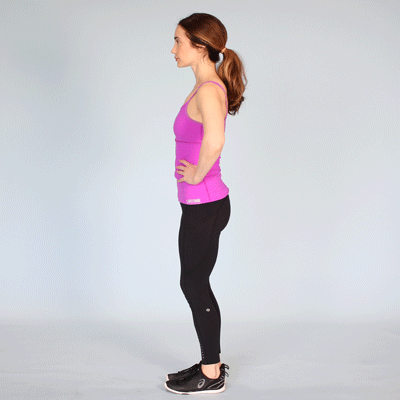
Stand with the feet placed hip-width apart.
Put your hands on your hips to provide extra balance.
Begin to tranfer your weight on your left leg.
Start bending your right knee while bringing your heel towards your glutes.
Make sure you are keeping your thighs aligned.
Slowly lower your foot and back to starting position.
Do it for your desired number of reps and repeat on your other leg.
Leg Swings
Stand straight with both of your feet together and your arms out wide.
Place your weight on your right leg and swing your left leg in front of you then swing it behind you.
Continue to utilize the momentum that is built up through the motion to complete your desired number of repetitions.
Once you have reached your desired number of reps switch to your opposite leg.
Burpees
Set your feet apart as you hold the arms by the side.
Lower your legs into the squat pose and place your hands flat on the ground.
Next, kick your legs backward as you lower the chest to the ground.
Push your chest to the start squat position.
Jump while lifting your hands over the head.
Downward Dog Leg Lift
Balance the body on the hands, while ensuring that the weight is evenly distributed.
As you exhale, continue extending the legs by raising the hip-high, toward the ceiling.
As one leg extends to the roof, the other stays put for balance.
Mountain Climbers
Your bodyweight should be equally distributed on the hands.
It should form a straight line from the shoulders to the ankles.
Lift one leg off the ground and raise the knee until it reaches the chest.
Return to the start position and repeat with the other leg at the desired speed.
Kickback Pulse
Stand upright as you turn to the side.
Kick the right leg back. Make sure you raise it so that it remains parallel to the floor.
Raise upward and pulse back and forth for about 30 seconds. The motions should be quick and controlled.
Continue with the opposite leg.
Snowboarders
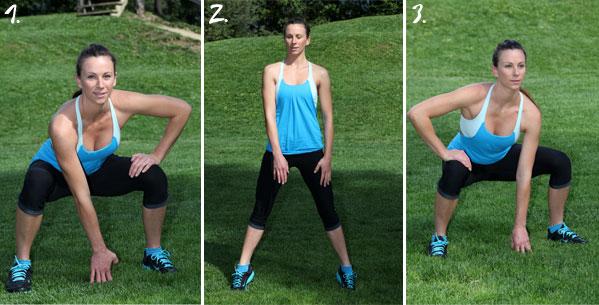
Start by standing upright while having the feet shoulder-width apart.
Perform quick motions as you squat and jump, concentrating on turning to 180 degrees before landing on another squat.
Repeat the 180-degree squat jumps as you change to the right and left.
Cross-legged Lift
Lie with your face up as your legs are straightened over the hips and arms. Keep your hands on the ground.
Bend your right knee, and cross the right leg over the left thigh.
The left thigh should remain straight.
Use the core muscles to raise the hips off the ground.
Repeat the motion with the next leg.
Pulse Ups
Lie flat on your exercising mat and put your hands so that they support the lower back.
Lift your legs until they are perpendicular to the floor.
Continue by raising the torso as you focus on contracting the core and reaching the legs.
Bicycle
Lie on the back while grabbing your fingertips behind the ears and the legs in the air.
Pull your knees towards the chest and begin moving your legs as you would if you were cycling.
Assure your chin is orientated towards the chest so that you can work your abs. Otherwise, the pressure exercised on the abdomen is minimal.
Crunchy Frog
As you sit in a V-like position, wrap the legs around the arms.
Next, open up the arms towards the sides while straightening the legs in front of you.
Pull your knees towards the chest and go back to the initial position.
Scissors
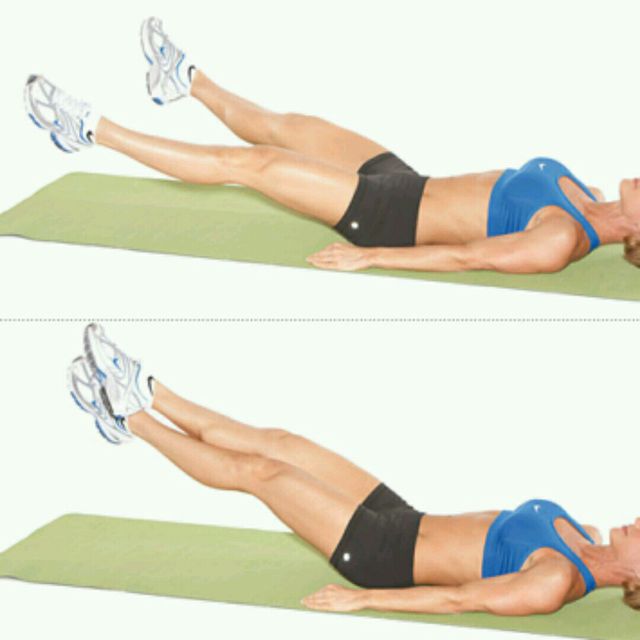
Lift your legs towards the roof.
This motion is followed by lowering the leg until it almost reaches the ground.
Switch with both legs.
Crunch Variation
Lie on the exercising mat while holding the arms on the floor for balance.
Raise your chin to maximize the pressure exercised on the abs.
Use both your legs to form parallel circles in the air.
Cross-body Mountain Climbers
Get into the push-up pose. Ensure that the hands are put a tad wider than the shoulder width.
The body should create a straight line from head to toe.
Pull your left knee as close as possible to the right elbow.
Go back to the starting position and replace the leg.
Keep on changing back and forth with both legs.
Your core should be contracted during the whole duration of the exercise.
High Skips
Stand with the legs about hip-width apart.
Jump on one leg and drive the other knee to the chest using your lower abs.
Swing the arms (the opposite arm and knee should be going up at the same time).
Change legs.
Forearm Bent Knee Hip Opener
Place your hands and elbows on the ground in a goal post position. Your shoulders should be over your elbows, with your supporting knee directly underneath the hip.
Lift your right leg and externally rotate the hip toward the ceiling with a flexed knee. Your spine should be straight, with no tucking and no arching.
Your torso should be square to the floor, while you should slightly twist your hips toward the right and to the ceiling.
Without transferring your body weight, pull your right bent knee toward your chest and then take it slightly behind you.
Do it five to eight times, then switch sides.
Knee to Elbow
Stand with the legs about hip-width apart.
Shift your weight to the right leg, and lift your right arm above your head.
Drive the left knee up toward the right side of the body, and at the same time, lower the elbow to meet your knee.
Repeat on the opposite leg.
Pull your elbow past the thigh to get the full benefit of this move.
Forearm Single-Leg Bicycle
Prop yourself up on your left elbow and right hand. Your left arm should be facing toward your body, with your left arm stacked directly on top of your left shoulder.
Your right arm should be on the floor with a slight flex elbow. Your shoulders are pulled away from the ears, and your spine is slightly twisting toward the right.
Extend your right leg, focusing on keeping a neutral spine throughout the whole exercise.
Swoop your right leg forward, bend the knee, swoop back slightly behind your body to the left, and extend your leg back to the center.
The motion should be a single-leg bicycle.
Do it five to eight times, then repeat on the other side.
Single Leg Crossover
Begin on all fours with your hands underneath your shoulders, your knees below your hips, and a neutral pelvis.
Extend your right leg behind you with a softly pointed toe.
Keeping your hips squared to the ground, tap your right foot to the right side of your body and then over to the left side of your body, crossing over to an internal rotation.
Do it five to eight times, then repeat on the other side.
Knee To Chest Plank

The feet should be a hip distance apart.
Pull your right knee into your chest, extend it behind you, then drop the right foot back down to the floor.
Do five to eight times, take to the child’s pose, then repeat on the opposite side.
Planking Twisted Chest Opener
Begin in a full plank position, raised through the back and with a neutral pelvis. Your hips and feet should be aligned.
Bend your right knee into your chest and cross it underneath the left side of your body, and drop it to the ground with a flexed foot.
Place your weight onto your right arm, open the left arm up to the ceiling, and drop your left foot to the floor, flexed.
Rotate your upper body back towards the ground and place your weight onto both arms before taking the right knee back into the chest and extending out into a plank position to start again.
Do it five to eight times, take to the child’s pose in between, then repeat on the opposite side.
Side-Lying Leg Lift
Prop yourself onto your left shoulder, making sure you are raised through the core and not lifting your shoulder towards the ear.
Place your head into your left hand for support. Your right hand is on the floor for extra support, too, but don’t put too much weight on that hand. Your spine should be neutral and raised. Your left hip should be on the floor, and the flexed knee is slightly in front of your body.
Extend your right leg to align with your spine. Draw the knee into your chest, extend it back out, and then do a little raise up to the ceiling.
Do it five to eight times, then repeat on the other side.
Squat and Lateral Leg Lift
Stand with the feet slightly wider than hip-width.
Transfer your weight back into a squat. Make sure you can see the toes at the bottom of the squat.
As you stand, press through your supporting leg and raise the opposite leg, keeping it straight and flexed, shooting energy out of your heel.
Put the leg down, and flex back into a squat
Change legs.
Side Plank Leg Lift
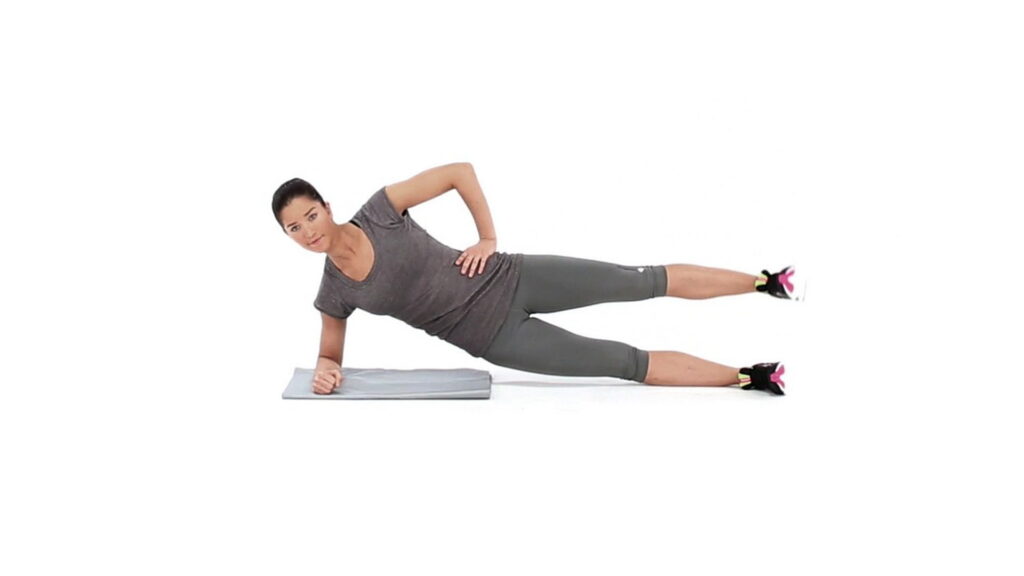
Prop yourself up on your left elbow, making sure the shoulder is stacked on top of the elbow.
Your arm should be facing the right. You will be in a side plank position with a raised hip, and the right knee is slightly in front of the body.
Raise your left leg without collapsing the spine or the shoulder, and then tap to the ground.
Do it five to eight times, then repeat on the other side.
Standing Single Leg Glute Press
Begin by clasping your hands in a prayer position and placing your weight onto your left heel. Your body should be slightly hinged forward but transferring your weight back to engage the left glute.
Extend your right leg behind you in parallel with a flexed foot.
Bend the knee and draw the left knee into your chest, focusing on maintaining the spine in neutral and not tucking the pelvis. Then push back behind you with the heel.
Do it five to eight times, then repeat on the other side.
Standing Single Leg Circle
Begin by clasping your hands in a prayer position and placing your weight onto your left heel. Your body should be slightly hinged forward but transferring your weight back to engage the left glute.
Extend your left leg out to the side with a soft pointed foot. You are going to circle the leg in a clockwise direction without transferring the body weight.
Do it five to eight times, then switch directions before switching to the opposite leg.

